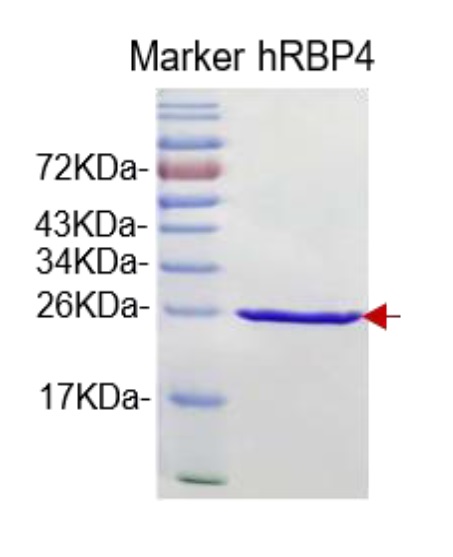Type
Recombinant protein
Description
Total 211 AA. MW: 24.4 kDa (calculated). N-terminal His-Tag and TEV cleavage site, 28 extra AA.
Amino Acid Sequence
MSYYHHHHHHDYDIPTTENLYFQGAMGSERDCRVSSFRVKENFDKARFSGTWYAMAKKDPEGLFLQDNIVAEFSVDETGQMSATAKGRVRLLNNWDVCADMVGTFTDTEDPAKFKMKYWGVASFLQKGNDDHWIVDTDYDTYAVQYSCRLLNLDGTCADSYSFVFSRDPNGLPPEAQKIVRQRQEELCLARQYRLIVHNGYCDGRSERNLL
Source
E. coli
Purity
˃ 90 % by SDS-PAGE
SDS-PAGE Gel
Endotoxin
< 1.0 EU/μg
Formulation
Lyophilized in 1 mg/ml in PBS.
Reconstitution
Add deionized water to prepare a working stock solution of approximately 1 mg/mL and let the lyophilized pellet dissolve completely.
Applications
Western blotting, ELISA
Storage/Expiration
Store lyophilized protein at -20 °C. Aliquot reconstituted protein and store at -80 °C. Avoid repeated freezing/thawing cycles.
Note
This product is intended for research use only.
Research topic
Diabetology - Other Relevant Products, Energy metabolism and body weight regulation
Summary
Retinol binding protein (RBP) 4 is the only specific transport protein for vitamin A in the circulation whose function is to deliver vitamin to target tissues (1). In obesity and type 2 diabetes, expression of Glut4 is significantly impaired in adipocytes. Glucose transport via Glut4 is the rate-limiting step for glucose use by muscle and adipose tissue (2). Yang et al. noted that adipocyte-specific deletion of Gluts led to notable elevation of RBP4 causing systemic insulin resistance, and that reduction of RBP4 improved insulin resistance (3). This identified a novel role of RBP4 in regulating insulin action and RBP4 is recorded as an adipocyte-derived hormone. Thus, measurement of serum or plasma RBP4 is a useful means for understanding of metabolic disorders.

